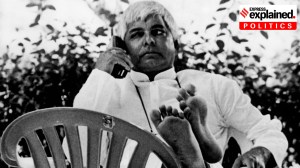MSRTC celebrates its Golden jubilee
PUNE, June 12: The Maharashtra State Road Transport Corporation (MSRTC) that celebrates its golden jubilee of dedicated service to the publi...

PUNE, June 12: The Maharashtra State Road Transport Corporation (MSRTC) that celebrates its golden jubilee of dedicated service to the public. It is a matter of pride for the entire state, as Pune enjoys a special place in the jubilations, with the first bus having been flagged off from the city to Ahmednagar in 1948.
It’s a story that had a hesitant beginning, with many people then not giving the State Transport (ST) bus service more than a couple of years of existence. Standing today by this milestone of 50 years, its position of strength speaks for itself – 16,000-odd buses, 12,000 employees, about 70 lakh citizens utilising the service daily.
Tracing the history that saw this development, we go back to the 1920s, when various entrepreneurs started their operations in the public transport scenario. Till the Motor Vehicle Act came into being in 1939, there were no regulations monitoring their activities, and this resulted in arbitrary competition, unregulated fares.
The implementation of the act rectified matters to an extent. The individual operators were asked to form a union on defined routes in a particular area. This also proved to be beneficial for travellers as some sort of schedule set in, with a time table, pick-up points, conductors, fixed ticket prices.Thus continued the state of affairs till 1948, when the then Bombay State Government, with the late Morarji Desai as the home minister, started its own state road transport service, called State Transport Bombay. And the first blue and silver-topped bus took off from Pune to Ahmednagar (this route being numbered one) under the supervision of D D Sathe, the then provincial motor transport controller.
Amongst the people gathered to watch this momentous occasion was Shashikant Mehendale, who went on to work with the MSRTC for a couple of years, before starting his own transport firm. “I watched with a cynical eye, convinced that it would not survive more than a couple of years. But my belief has obviously been proved baseless,” he says with a smile. “My father was one of the private operators who closed shop after the State transport came into being and following him, I too joined at the Central Workshop at Dapodi where Arthur Van Rhee, a Swede, was the works manager. And his chief superintendent was the late H K Firodia!”
Pulling out some more tales from his cache of memories, he continues, “I remember that the driver and conductor used to wear khakhi uniforms and peak caps. There were 10 makes of buses in use then – Chevrolet, Fort, Bedford, Seddon, Studebaker, Morris Commercial, Albion, Leyland, Commer and Fiat.
In the early 1950s, two luxury coaches were also introduced with Morris Commercial Chassis. These were called Neelkamal and Giriyarohini and used to ply on the Pune-Mahableshwar route. They had two by two seats, curtains, interior decoration, a clock and green tinted glasses,” he recalls.
In 1950, a Road Transport Corporation Act was passed by the Central Government and it delegated powers to states to form their individual road transport corporations with the Central Government contributing one-third of the capital. The Bombay State Road Transport Corporation (BSRTC) thus came into being, later changing its name to MSRTC with the re-organisation of the state.
“The ST started with 30 Bedford buses having wooden bodies, coir seats and the fare charged on the Pune-Nagar route was nine paisa,” says G M Patil, retired deputy general manager, MSRTC, whose association with the ST spans 36 years. Having seen the ST undergo many changes, he lists them off – increasing the seating capacity from the original 30 to 45 to the present 54, introduction of all-steel bodies to replace wooden bodies to make them stronger and cushion seats for more comfort. Later, in 1960, aluminium bodies were introduced as steel corrodes, especially in coastal areas, and the colour code also changed to red from the blue and silver. A partial night service was launched in 1956, the overnight service about a decade later and the semi-luxury class came into being during the Asian Games in 1982.
Significantly, the ST does not only carry people but also takes care of the postal mail, distribution of medicines, newspapers and even tiffins to children studying in the bigger towns. In rural areas, it aids farmers to transport their goods to the cities. All this in the face of bad roads, recurring losses, hiked taxes and yet it retains its identity of a transport service for everybody.
No matter what, the ST reaches every village that is connected by road, however bad it may be, truly living up to its motto of `jithe rasta, tithe ST’ (where there’s a road, there’s an ST bus)!



- 01
- 02
- 03
- 04
- 05



























